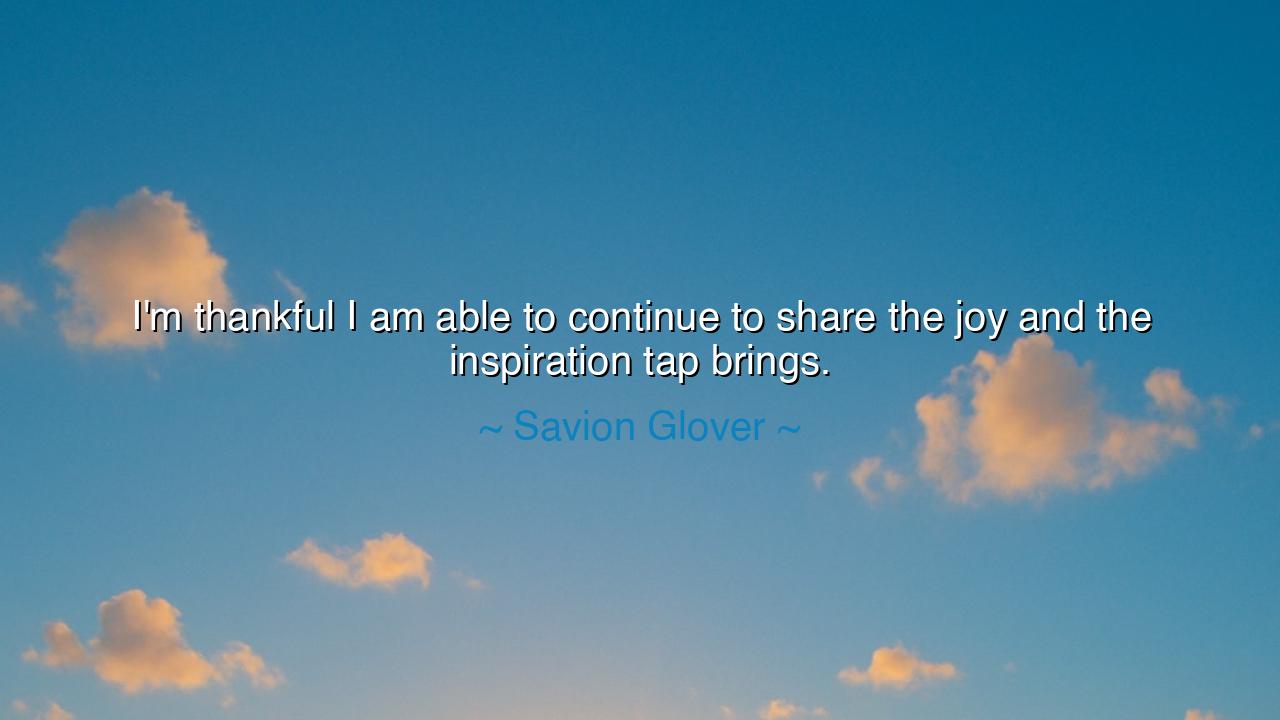
I'm thankful I am able to continue to share the joy and the






When Savion Glover declares, “I’m thankful I am able to continue to share the joy and the inspiration tap brings,” he speaks as a keeper of an ancient rhythm, a guardian of a tradition that is both personal expression and communal heritage. His words are not just those of a performer, but of a servant to an art form that transcends entertainment. Tap is not mere movement of the feet; it is storytelling through rhythm, the voice of history striking the ground, echoing the struggles, triumphs, and celebrations of a people. His thankfulness is the gratitude of one chosen to be a vessel for something greater than himself.
To speak of joy and inspiration is to recognize that dance is more than performance — it is healing, uniting, and awakening. Tap has long carried the soul of resilience, born from the blending of African rhythms and Irish jigs, forged in the fires of hardship, yet turned into art. When Glover says he is thankful to share it, he acknowledges that every shuffle, every stomp, every beat carries with it the laughter of children, the pride of ancestors, and the spark of creativity that lights the hearts of those who witness it.
History tells us of the ancient griots of Africa — poets and musicians who carried the memory of their people in song and rhythm. They did not create for themselves alone but for the community, for the survival of culture, for the strengthening of spirit. In the same way, Glover places himself in service to tap, ensuring that its rhythm continues to inspire not only those who love the stage but also those who need its message of perseverance and joy.
His humility is woven into the word “thankful.” He does not boast of his skill, though he is a master, nor of his fame, though he is known. Instead, he bows to the opportunity to share. For true greatness does not lie in possessing a gift but in offering it freely so that others may be lifted by it. Gratitude transforms talent from self-centered pride into sacred service. Glover’s example is a reminder that our gifts reach their highest purpose when they become blessings to others.
The deeper teaching here is that art is a bridge. Tap dancing is not only movement, but a dialogue between artist and audience, between past and present. Each performance is both personal expression and communal inheritance. To share the inspiration tap brings is to awaken in others the courage to create, to persevere, and to find joy in movement and rhythm even in times of difficulty. Glover’s thankfulness is thus gratitude for being part of this eternal cycle of giving and receiving.
For us who hear these words, the lesson is clear: whatever your craft, be it great or small, share it. Do not hoard your talents for your own glory, nor believe that they are insignificant. If they bring joy, if they inspire, if they heal even one person, then they are already sacred. Be thankful for the chance to use your gift, and dedicate yourself to passing it forward, so that the chain of inspiration never breaks.
Therefore, O seekers, carry this teaching into your days: let your life be like Glover’s tap — full of rhythm, alive with joy, and given freely as inspiration to others. Be thankful not only for what you have received, but for the chance to share it. For in the sharing of joy, in the offering of art, in the rhythm that connects one soul to another, you fulfill the highest calling of humanity — to leave behind not silence, but a song that echoes into eternity.






AAdministratorAdministrator
Welcome, honored guests. Please leave a comment, we will respond soon